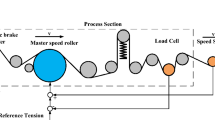Abstract
Winding is an integral operation in almost every web handling process, and a center-wound roll is one of the suitable and general schemes in a winding system. However, improper internal stresses within a center-wound roll can cause damage such as buckling, spoking, cinching, etc. Wound roll quality and performance are known to be related to the distribution of in-roll stresses. It is therefore necessary to analyze the relationship between taper tension in the winding section and internal stress distribution within the center-wound roll to prevent winding failure. But it is hard to compensate for an undesirable winding roll shape such as starring, buckling, and telescoping. This is because the winding section is the final process in a roll to roll system and has no feedback control system to correct winding roll shape directly. A time varying tension profile and accurate control of it in a winding section is one way to shape the fail-safe in-roll stress distribution of a winding roll. In this study, a new taper tension profile making method is aimed for designing high quality wound rolls. A new method to determine the proper taper tension profile was designed by analyzing the winding mechanism which includes the stress model in center-wound rolls, nip induced tension model, relationship between taper tension profile and telescoping, relationship between taper tension type and internal stress distribution. An auto taper tension profile making method was proposed not only to optimize radial stress distribution but also to minimize lateral error (telescoping). Simulation results show that the proposed method is very useful for determining the desirable taper tension profile during the winding process and preventing defects of winding roll shape such as telescoping, starting, and dishing and so on.
Similar content being viewed by others
References
H. C. Altmann, Formulas for computing the stresses in center-wound rolls, Tappi Journal 51 (1968) 176–179.
H. P. Yagoda, Resolution of a core problem in wound rolls, Journal of Applied Mechanics 47 (1980) 847–854.
Z. Hakiel, Nonlinear model for wound roll stresses, Tappi Journal 70 (1987) 113–117.
J. K. Good, J. D. Pfeiffer, R. M. Giachetto, Losses in wound-on-tension in the center winding of wound rolls, Proceeding of the Web Handling Symposium, ASME Applied Mechanics Division 149 (1992) 1–12.
S. J. Burns, R. R. Meehan and J. C. Lambropoulos, 1999, Strain-based formulas for stresses in profiled center-wound rolls, Tappi Journal 82 (7) (1999) 159–167.
K. H. Shin., S. O. Kwon, The effect of tension on the lateral dynamics and control of a moving web, IEEE Trans. on Industry Applications 43 (2005) 403–412.
J. Shelton, Lateral Dynamics of a Moving Web, Ph. D. dissertation, Oklahoma state Univ. Stillwater, USA (1986).
J. Shelton, K. N. Reid, Lateral dynamics of a real moving web, ASME Journal Dynamics, Syst., Measurement, Control 93 (1971) 180–186.
J. Shelton, The effect of camber on handling, Proceeding of the international Conference on Web Handling, Oklahoma state Univ. Stillwater, USA (1997) 248–263.
Author information
Authors and Affiliations
Corresponding author
Rights and permissions
About this article
Cite this article
Lee, C.W., Lee, J.W., Shin, K.H. et al. A taper tension profile maker in a converting machine. J Mech Sci Technol 22, 77–84 (2008). https://doi.org/10.1007/s12206-007-1009-6
Received:
Revised:
Accepted:
Published:
Issue Date:
DOI: https://doi.org/10.1007/s12206-007-1009-6




